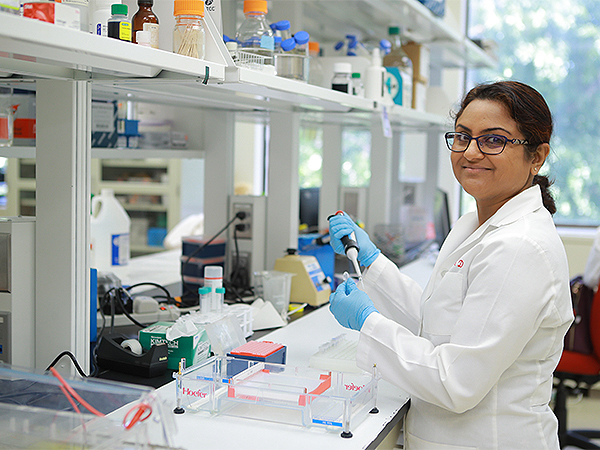UToledo faculty break new ground in research, attract project funds
University of Toledo researchers Dr. Bina Joe, Dr. Mike Weintraub and Dr. Mohammad Elahinia are among the many UToledo faculty members who are experimenting, testing and contributing new technologies, therapies, scholarship and creativity to improve the human condition.
Last month, we featured the soil ecology research of Dr. Mike Weintraub, and this month we focus on the research of Dr. Bina Joe, director of the Center for Hypertension and Precision Medicine. In March, Dr. Mohammad Elahinia’s research on shape memory alloys will be featured. (To read about research funding, click here.)
Dr. Bina Joe looks to gut bacteria for treatment of common hypertension
Dr. Bina Joe, director of the Center for Hypertension and Precision Medicine, has consistently been funded by the National Institutes of Health for her investigations into treating hypertension, and since 2004 has garnered $20 million in NIH funding.
Joe focuses on the communities of microorganisms that reside in the gut, as well as inherited genes, to look at how environmental influences, such as salt consumption, can disturb microbiota and present as disease.

Dr. Bina Joe’s lab
“Does environment override what we have in our inherited DNA, or does it add to what we have from Mom and Dad? Where do microbiota come into the picture here?” she asks. “Just because you got A,B,C bad genes from Mom and Dad, some microbiota will sit in your body, but they’re not going to promote disease until you have a second hit of the diet. For example, when one has genetic susceptibility for hypertension, eating salt promotes certain groups of microbiota, which will grow in population and release biochemicals that raise blood pressure,” says Joe.
Joe is digging deeper into microbiota and hypertension using rat models to understand the many ways in which these microbes benefit health. “The largest concentration of microbiota lives in the gut. Others reside in the mouth, skin, nose and other exposed parts of the body,” says Joe. “Those in the gut are the most essential for health. They break down fiber for us. Without them we can’t digest fiber and use it for our health.”
She explains the shift over time from external to internal germs that have caused disease in humans. “In the 18th century, what did people die of? They died of infectious diseases (influenza, tuberculosis and others). Pathogens outside of our bodies,” she says. “Now what are we dying of? We’re not dying of those. We’re dying of cardiovascular disease and cancer. These are also caused by germs, but the germs that are inside our body.”
Joe says the development of antibiotics provided a way to kill off the pathogens, and in that process, antibiotics have disrupted human microbiota. “We have destroyed our inner ecosystem,” she says. Killing off microbes that humans need has “introduced other diseases for the host. That’s the science, that’s the thinking,” she says.
“We have a powerful tool here in looking at our microbes. It’s a very specialized science for understanding how this ecosystem of important germs, called commensal germs that are inside our body, live with us symbiotically. So, we need them; they need us. We have this relationship built in through evolution. When you disturb that symbiosis that is when the host is getting disease,” she explains.

Dr. Bina Joe presents at the American Heart Association’s Joint Hypertension 2019 Scientific Sessions in New Orleans this past September, where she also accepted the Harriet Dustan Award. The conference is the premier basic and translational hypertension conference with the AHA’s Council on Hypertension and Kidney in Cardiovascular Disease. Photo by © AHA/Matt Herp 2019
Joe is awaiting word from the NIH about the acceptance of another grant proposal she and three other faculty members prepared. Her lab already has used the gene-editing tool called CRISPR/Cas9 to genetically engineer rats, and they will develop new experiments to expand on the current research should they receive the grant. “A good experimental design would have only one variable between a control and experimental,” says Joe. “In this case, the variable would be presence or absence of microbiota. That’s the kind of study we want to do,” she says.
These new studies require beginning with germ-free rats that have no microbiota. “So, we have to derive them to be germ-free, house them in a germ-free condition and study the salt-sensitive hypertension connection to microbiota of these animals,” she explains.
Medical research constantly advances, but until scientists can pinpoint the causes of diseases, there can be no magic pills to cure them. “A magic pill is a false hope,” says Joe. “There are pills to control blood pressure; there are quite a few on the market, but unless we find the causes for hypertension and target such causes, we may not be able to reduce the incidence of high blood pressure. Gut microbiota present with an opportunity as one of the potential causes, whereby hypertension could be managed in the future through microbiota treatments, which ensures a better quality of life.”
